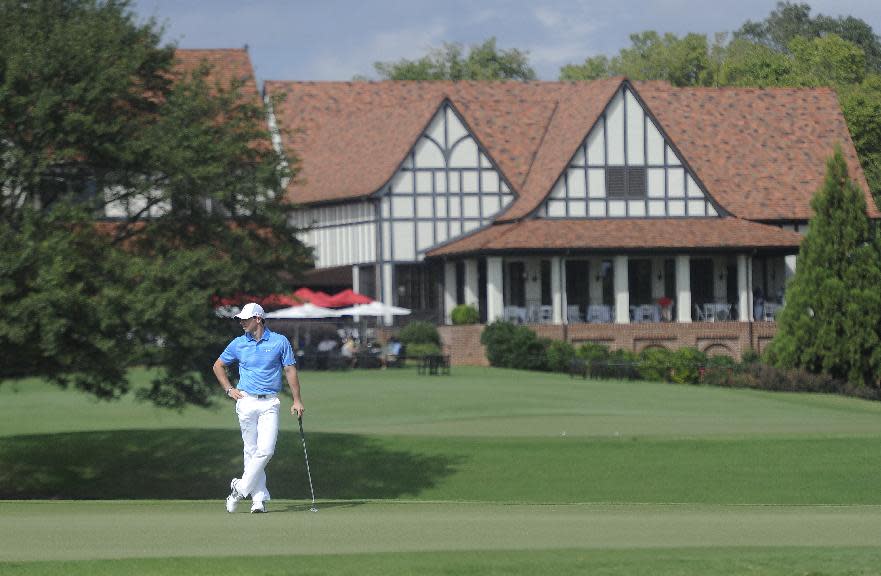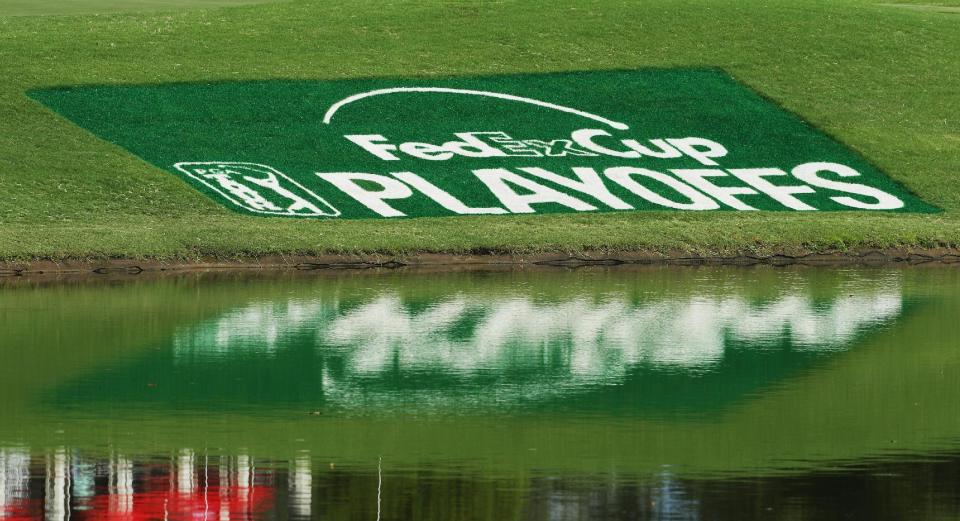The PGA Tour has a serious football problem

EAST LAKE, Ga.—Three hundred thirty-seven miles west of Atlanta’s East Lake Golf Club, give or take a five-iron, the Georgia Bulldogs spent most of Saturday afternoon getting pummeled by Ole Miss. At the same time, about 680 miles north, an unspectacular Notre Dame team prepared to kick off against an equally uninspiring Duke squad. Like the moon shaping the tide, these two games, and others like them, have had an unseen but dramatic impact on the end of the PGA Tour season.
This ought to be a time for golf to celebrate a season that featured four first-time major winners as well as a triumphant return to the Olympics. Instead, the Tour Championship, as it always is this time of year, takes a back seat—a far back seat—to the NFL and college football. The season-ending FedEx Cup, a four-tournament showdown that concludes at the Tour Championship, awards a fat $10 million check to the winner. But even that isn’t enough to vault the tournament past football and stretch-run baseball. It’s a definite problem for the Tour, but it’s one with a visible, if tricky, solution.
Let’s start by pointing fingers. Football is the most obvious culprit; once toe meets leather, the nation’s entire weekend attention shifts away from baseball, golf, tennis, NASCAR, family, religion … really, everything. Football doesn’t just eat into attendance at East Lake—though this is the South, where couples who schedule their weddings the weekend of rivalry games get married in half-empty churches—it demands the entire attention of a nation of TV viewers.
“This time of year, you’ve got people waiting six, seven months for football to start up,” William McGirt told Yahoo Sports shortly after the end of his round. “It’s tough going up against that.”
Football also forces an entire gravitational shift on the tournament itself, making players tee off several hours early on Saturday so that everyone’s done in time for Notre Dame’s 3:30 p.m. Eastern kickoff. Leaders Dustin Johnson and Kevin Chappell walked off the 18th green at exactly 3:21, time for a quick TV wrapup before kicking coverage over to football.
That’s due to NBC’s competing broadcast arrangements with both the Irish and the Tour, but think about that for a second. The Tour altered one entire day of its marquee tournament to accommodate a meaningless college football game. Augusta National would’ve told the network to pound sand.
The PGA Tour, though, doesn’t have the kind of muscle that Augusta can wield for a weekend; the Tour, rather, lies bound in a sticky web not entirely of its own creation. First off, the sweep of golf’s narrative doesn’t work like other sports; this game operates in terms of decades, not weeks. The prevailing wisdom among both players and fans is that the four majors—the Masters, the U.S. Open, the British Open, and the PGA Championship—reign supreme. The “season” thus runs from the moment Jack Nicklaus opens the Masters with a ceremonial tee shot on a cool April Thursday morning to the moment when a golfer hoists the Wanamaker Trophy to end the PGA Championship on a balmy August Sunday evening.
However, as a result of decades of bureaucratic power struggles and longstanding tradition, the PGA Tour doesn’t control any of the four majors. It’s the equivalent of the NFL hosting every regular-season and playoff game and then outsourcing the Super Bowl, with all its attendant glory and history, to a completely different entity.
The Tour has tried, with varying degrees of success, to create its own showpiece events. The Players Championship, currently played in May, features the strongest field of the year, but it’s new money in an old money world. No matter how competitive and compelling The Players may be—and indeed it is, year after year—it’s no major.

The Tour Championship dates back to 1987, and for much of its history, it brought together the year’s top 30 money winners for a chance to claim another paycheck. Then, 10 years ago, the Tour spot-welded a new creation, the FedEx Cup, onto the Tour Championship with two objectives in mind: first, to give a definitive end to the season in the wake of the majors, and second, to create a brand-worthy event, the FedEx Cup, that the Tour could market to hell and back. (That’s not a direct quote of PGA Tour commissioner Tim Finchem, but it sums up his intentions.) It’s also worth noting that this year the Tour Championship faces a wicked one-two calendar punch from both the Olympics, which ran last month, and the Ryder Cup, which kicks off next week.
The four-tournament FedEx Cup that culminated in the Tour Championship had a bumpy start; the initial points structure had a loophole that allowed someone to win the whole thing before even teeing off at East Lake, as Vijay Singh did in 2008. The next year featured the popular but peculiar scene of Phil Mickelson winning the Tour Championship and Tiger Woods winning the overall FedEx Cup. And in later years, the points system was so confusing that TV commentators armed with whiteboards parsed out the possibilities like they were performing shuttle re-entry calculations.
But repeat something long enough and it becomes tradition, and golf fans are now accustomed to seeing “FedEx Cup Points Standings” accompanying even the most off-the-radar early-season tournaments. Plus, the game generally self-selects the best players to play at East Lake; sure, a Billy Horschel or a Brandt Snedeker might win the big prize, but you can count on big dogs like Jordan Spieth, Rory McIlroy, and Dustin Johnson being in contention. This ought to be one of the circled dates on the calendar, not a box on the to-do list.
So what’s to be done? In football terms: punt. In golf terms: lay up. Move the Tour Championship to Labor Day weekend, claiming the last Sunday of summer for the sport of summer. Football owns everything on television this side of zombies; a more narrow-appeal sport like golf isn’t going to be the one to break that streak. There’s no shame in knowing one’s limitations.
A major factor in changing the schedule is the current broadcast agreement, which grants broadcast rights to CBS and NBC and, of course, guarantees the PGA Tour income through 2021. However, the PGA Tour can opt out of its current agreement in 2018, and it’d be in the best interests of everyone involved to give renegotiation a serious consideration. The Tour could renegotiate its schedule, and in theory could even join the NFL, NBA, and Major League Baseball in creating its own network.
One problem with that strategy, of course, is the risk associated with opting out. We’re in a sports-rights bubble right now, with virtually every league locked down in long-term deals that reach into the billions, predicated heavily on raking in cash even from cable customers who aren’t watching live sports. But cord-cutters are having an impact on cable companies’ bottom line, and that deficit rolls downhill. Somewhere, sometime soon, when renewal time comes around one league is going to find its rights fees cratering, and golf obviously doesn’t want to be the first sport over that cliff. (There’s also the Tiger Factor; while Spieth, Johnson et. al. are powerful draws, they’re not the kind of visible-from-space attraction that Woods was.)
Granted, not every player sees a problem; many make public pronouncements in support of the way things are now. “I don’t think it makes that much of a difference [when the Tour Championship is scheduled],” Spieth said. “I never noticed that the galleries were smaller in New York, in Boston, in Indianapolis [at previous FedEx Cup playoff stops].”
“It’s just anything, you know,” Bubba Watson said. “What if you’re a NASCAR fan? What if you want to watch NASCAR on Sunday? Or Saturday night, depending on what race it is. You’re always going to be battling something. Just how it goes.”
But let’s say for the sake of argument that the schedule change is on the table, and broadcast rights negotiation is a workable possibility. What would a newly constituted PGA Tour season look like? Just like the current one: crowded. The 2017 PGA Tour season begins in less than three weeks, just days after the end of the 2016 Ryder Cup. And from there, we’ll have tournaments on 48 weeks, with only a short break in early October and a slightly longer one around Christmas standing between the Tour and a year-long schedule.
“I’ve always assumed you’d run out of days to play tournaments if you ended on Labor Day,” Kisner said. “I don’t see how it would be possible.” He’s right, under the current system. There’s not enough time between the PGA Championship in August and Labor Day to schedule a playoff under the current four-tournament structure.
So it’s time to get creative, like Phil Mickelson from the rough. Here’s one oft-aired theory, and it’s a good one: move The Players from May to March, a win-win both because it provides an earlier start to big-tournament (we didn’t say “major,” golf purists) season and because TPC Sawgrass in Ponte Vedra, Fla. won’t be baked out. Then move the PGA Championship out of its current August slot and into May. That gives roughly six weeks between the end of the British Open and Labor Day, more than enough time to get in three playoff tournaments and the Tour Championship.
What’s trickier will be dealing with all those 48 weeks of tournaments. Granted, it’s not mandatory that players play in all, or even most, of the tournaments. But the PGA Tour seeks to broaden its reach to every corner of the planet—Finchem spoke this week of the 230 countries that will be viewing the Tour Championship—and one way to do that is to have as many opportunities as possible for as many players as possible.
The NFL and college football flourish because of scarcity, because they fit their regular seasons into one-third of the calendar. Every other sport could benefit from some healthy pruning, none more than golf. But when you’ve got broadcast commitments, sponsor buy-ins, and charitable donations predicated on a certain number of tournaments, it’s tough to take a hatchet to the schedule.
So if the Tour is indeed going to go with a year-round slate of tournaments, just pick up the next season in September rather than October. Sure, they’d still be up against football, but not with the Tour’s gem event.
Just don’t ask the players when they’d want to pick up the clubs again.
“January,” McGirt laughed, “so we can have an offseason.” And, he might have added, a little time to kick back and watch some football, too.
____
Jay Busbee is a writer for Yahoo Sports and the author of EARNHARDT NATION, on sale now at Amazon or wherever books are sold. Contact him at jay.busbee@yahoo.com or find him on Twitter or on Facebook.

 Yahoo Nachrichten
Yahoo Nachrichten 
